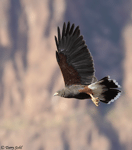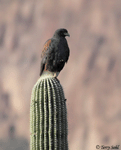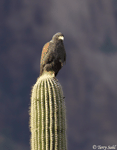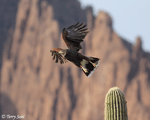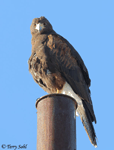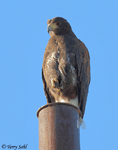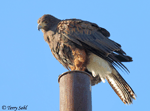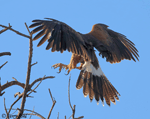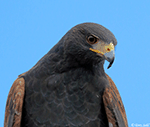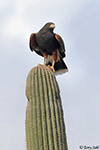| Length: 20 inches | Wingspan: 42 inches | Seasonality: Non-resident in South Dakota |
| ID Keys: Dark brownish overall, rufous shoulder, white undertail coverts, white band on tip of tail | ||
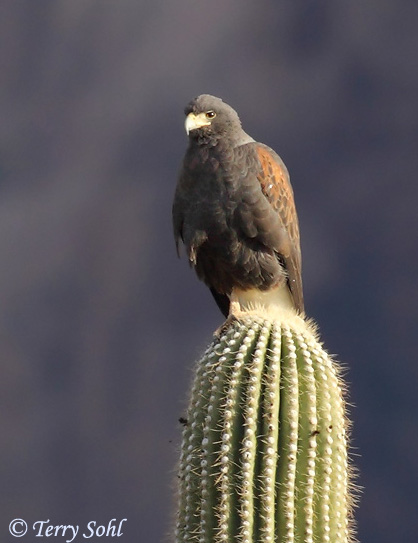 The Harris's Hawk is a raptor of dry habitats in the southwestern United States.
Their range also extends southward through much of Mexico and into South
America. They are unusual compared to the similar Buteo family of
hawks in that they are relatively social. Small groups of 2 or 3
(occasionally up to 8) Harris Hawks will roost and hunt together, with
individual birds cooperatively chasing prey, with one bird flushing the prey
and another capturing it. When prey is captured, it is often consumed
by multiple birds in the social group. They are equally unusual in
their nesting habits. One female will often raise young in conjunction
with two males, with all three adult birds helping to incubate the eggs and
raise the young.
The Harris's Hawk is a raptor of dry habitats in the southwestern United States.
Their range also extends southward through much of Mexico and into South
America. They are unusual compared to the similar Buteo family of
hawks in that they are relatively social. Small groups of 2 or 3
(occasionally up to 8) Harris Hawks will roost and hunt together, with
individual birds cooperatively chasing prey, with one bird flushing the prey
and another capturing it. When prey is captured, it is often consumed
by multiple birds in the social group. They are equally unusual in
their nesting habits. One female will often raise young in conjunction
with two males, with all three adult birds helping to incubate the eggs and
raise the young.
Habitat: Harris's Hawks are found in a variety of dry, open habitat. In the Sonoran Desert they are found in saguaro cactus deserts, while in New Mexico and Texas, they are found in mesquite woodlands and riparian zones.
Diet: Feeds on many different small animals, including rodents and other small mammals, birds, lizards, snakes, and large insects.
Behavior: More gregarious than many hawks, with two or more Harris's Hawks often roosting together and hunting together. Hunting is most often done by flying relatively close to the ground and rapidly pursuing prey if spotted. When hunting cooperatively, Harris's Hawks will often share larger prey items that are caught.
Nesting: The nest of a Harris's Hawk is a bulky platform of sticks, usually lined with twigs and grasses. The nest is typically in the crook of a saguaro cactus or in a small tree. Both males and females will help to build the nest, incubate the eggs, and help to raise the young.
Song: High-pitched screaming coweeeeeeeer.
Migration: Considered a permanent resident throughout its range, although some birds make short distance movements in response to feeding opportunities.
Interactive eBird Map: Click here to access an interactive eBird map of Harris's Hawk sightings
Similar Species: Common Black Hawk, Zone-tailed Hawk, Swainson's Hawk
Conservation Status: Numbers have declined in recent decades in the United States portion of their range. However, globally there are currently no perceived major threats to Harris's Hawk populations, and the IUCN cites it as a species of "Least Concern".
Further Information: 1) Cornell's All About Birds - Harris's Hawk
2) Audubon.org - Harris's Hawk
3) University of Michigan's Animal Diversity Web - Harris's Hawk
Photo Information: December 10th, 2010 - Saguaro National Park, Arizona - Terry Sohl
| Click below for a higher-resolution map |
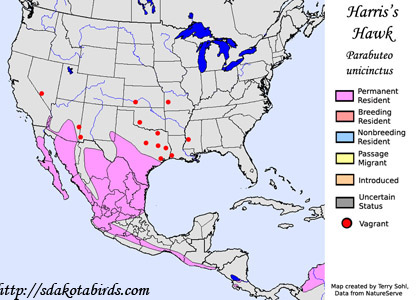 |
| South Dakota Status: Non-resident in South Dakota |
Additional Harris's Hawk Photos
Click for a higher-resolution version of these photos
